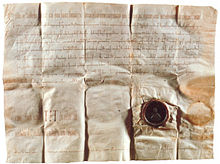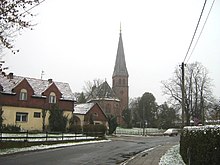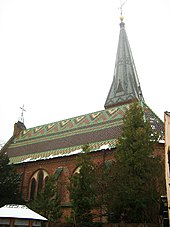Geltow
|
Geltow
Schwielowsee municipality
|
||
|---|---|---|
| Coordinates: 52 ° 21 ′ 46 ″ N , 12 ° 58 ′ 24 ″ E | ||
| Height : | 32 m | |
| Area : | 9.3 km² | |
| Residents : | 4081 (Jan 27, 2016) | |
| Population density : | 439 inhabitants / km² | |
| Incorporation : | December 31, 2002 | |
| Postal code : | 14548 | |
| Primaries : | 03327, 033209 | |
|
Location of Geltow in Brandenburg |
||
Geltow is a district of the municipality of Schwielowsee in the Potsdam-Mittelmark district with 4082 inhabitants and an area of 930 hectares.
history
middle Ages
Geltow was first mentioned (together with Potsdam ) as Geliti in a deed of gift issued in Merseburg on July 3, 993. King Otto III. gave his aunt Mathilde , the abbess of the Quedlinburg monastery , two places, called Potztupimi and Geliti, located in the province called Hevellon and on the island of Chotiemnizles ( lat. […] duo loca poztupimi et Geliti dicta in provincia Hevellon Vocata et in insula Chotiemnizles sita […] ) Stone axes and shards of vessels from the 4th millennium BC found on site Chr. Suggest a settlement of the place since the Stone Age . Other bronze finds indicate that in the 18th century BC Existing first trade relations. In order to be able to cross the Havel , a ford was paved in the water from horse skulls. The horse skull in the municipal coat of arms finds its explanation in it. The discovery of numerous Roman coins from the time of Gordianus III. Pius shows the importance of the Havel crossing as a supra-regional trade route. After the Semnones , whose tribesmen mostly fled from the Huns to southwest Germany, settled in the 6./7. Century Slavs the area. The new settlers from the League of Liutizen were called "Heveller" by later German conquerors. The place name has its origin also in this time and is from the word Jelity or Jelito emerged that as much as the large intestine , blood sausage , or even a fool can mean. Other sources translate jelity as clay-like . After different spellings over the centuries, the name Geltow is known from around 1684.
A second written mention of Geltow is in a document from 1242, in which the Margraves Johann and Otto confirm the transfer of four Hufen land by Knight Baldewin (or Balduin) Trest, owner of Jelt, to the Lehnin monastery .
Modern times
After various changes of ownership, whose owners included aristocratic families such as von der Gröben (named 1375) and von Hake (from 1441 to 1663), the "Great Elector" Friedrich Wilhelm bought the place including the surrounding lands from the Hakes and divided the estate into Potsdam office. In 1747 Frederick the Great transferred the Vorwerk to the Potsdam military orphanage in hereditary lease, with the order "to provide the children in the Potsdam orphanage with food." Since the directorate of the orphanage was in Bornstedt , the Geltow Vorwerk came to the Bornstedt office in 1747, where it continued up to 1826 stayed. In addition to the old Geltow, during the reign and at the expense of Frederick the Great between 1776 and 1778, a colonial settlement for 16 Prussian war invalids was built at the exit towards Potsdam. For the new settlers and most of the 166 villagers counted in 1772, fruit and vegetable cultivation developed into a livelihood during this period. In his hikes through the Mark Brandenburg , Theodor Fontane later describes the difference between Old and New Geltow: “The village character had ceased and summer houses had taken its place; small, one-story, but very clean and wherever there was a front garden or where caprifolium and rose bushes surrounded the door and window, full of grace and picturesque charm. ”It was not until 1912 that the two districts of Alt Geltow and Neu Geltow were merged.
From 1872 to 1939 the community belonged to the Osthavelland district , then to the Potsdam-Land district until 1952 and to the Potsdam-Mittelmark district that was created in 1993 as part of the district reform. On the western slope of the Schäfereiberge, Geltow had a ski jump. It was built in 1958 by the members of SG Geltow. The inrun tower was made entirely of wood and was eleven meters high. The difference in height from the tower to the outlet was 45 meters. The hill record was around 29 meters. However, the facility fell into disrepair due to a lack of money and, in particular, a lack of snow.
On December 31, 2002, Geltow, Caputh and Ferch merged to form the new community Schwielowsee.
Geltow as a garrison location
In 1936, the Luftkriegsschule III , which moved to Oschatz in Saxony in 1944, and the command center of the Luftwaffe were built in Geltow . This included an airfield in Werder (Havel) that no longer exists today . During the Second World War , the telecommunications office of the Reich Aviation Ministry , where Harro Schulze-Boysen was also employed, was relocated here for security reasons . The Berlin Flak searchlight group had a training battery for air force helpers in Geltow, and the barracks camp was operated on the lake.
The Land Forces Command of the National People's Army of the German Democratic Republic was set up on December 1, 1972 in Geltow. When the NVA was decommissioned, the command was dissolved in 1990. The legal successor was the Bundeswehr Command East . The Bundeswehr's command and control command is currently stationed here.
Transport links
Geltow is on the Bundesstrasse 1 , which leads from Potsdam to Brandenburg (Havel). Geltow is connected to Potsdam and Werder by bus route 631 operated by Havelbus mbH. The Caputh ferry connects Geltow with the neighboring district of Caputh . The Potsdamer Havel , a federal waterway , flows past Geltow . Passenger shipping companies offer excursion routes on the Havel lakes in the area as well as regular boat connections to and from Potsdam from the landing stage directly at the Baumgarten Bridge.
The stop "Caputh-Geltow" is the railway connection of the place, even if it is a 15-minute walk from the train station (which is located at the ferry to Caputh) to the next inhabited street. The regional train line RB23 from Potsdam Hbf to Beelitz-Heilstätten passes here.
Buildings
The village church
Over the years three churches have been built in Alt Geltow. The construction of the first stone church is unknown. The second half-timbered church was built in 1727 during the reign of the soldier king Friedrich Wilhelm I , who took over the costs and patronage . In a chronicle from 1755, the pastor wrote: “[…] the demolition of the very old church built on field stones in 1727; and a larger one and a tower made of wood were built. The tower, however, which is very exposed to the weather, soon rotted and splintered by the thunderstorm in 1750, June 24th, without being ignited, so that it had to be demolished in 1751. A new massive tower was built in 1755 and cost 800 and several Reichsthaler. ”( Chronicle of 1755 ) Theodor Fontane describes the interior:“ [...] we step in and look around the simple room: white walls, a wooden ceiling and close to the gable wall an anxiously high pulpit, to which a steep, straight side staircase leads. ”( Fontane: Migrations ) In 1885 this church was dilapidated and was torn down. In October of the same year, work began on a new church building in neo-Gothic style based on plans by Emil Gette . The inauguration took place on December 22nd, 1887. Crown Prince Friedrich Wilhelm, who later became the “99-day emperor” Friedrich III, influenced the appearance . and his wife Victoria . On June 6, 1888, nine days before his death, he and his family visited the Geltower church for the last time. Theodor Fontane dealt with this event in his poem “Kaiser Friedrich III. last ride ”, the signatures of the Hohenzollern in the old church Bible also testify to the presence of the imperial family. At the request of the then crown prince, the building shows similarities with the church in Terlan , South Tyrol . The slender tower with its pointed helmet, a side aisle and the sacristy are attached to the side of the main nave. The red brick walls are structured by bands of green glazed bricks and the church roof has a colored pattern of red, green, yellow and brown tiles.
Baumgarten Bridge
The Baumgartenbrücke is a road bridge that leads the Bundesstrasse 1 between Geltow and Petzow over the Potsdamer Havel .
Attractions
Active museum
The active museum "Henni Jaensch-Zeymer" is located in the village . In 1932, after working in the Gildenhall artists' settlement and in Rangsdorf, the artisan weaver was looking for a new place to work in order to be able to cope with the growing number of orders. The artistic training in drawing schools and getting to know hand weaving in the Rhön were the basis of her further activities. Influenced by the teaching of the artisan Else Mögelin ( Bauhaus student) and the community of artists in Gildenhall by the Bauhaus ideas, she developed her own style. The motto “The Art of Leaving Out” becomes her artistic driving force.
Zeymer found the right place for his own workshop in the empty inn in Alt-Geltow. In 1939 she set up her weaving yard here and procured handlooms from various regions of Germany and Silesia. The old dance hall of the inn becomes a workshop. The stage is converted into an apartment and studio. Today the former taproom is the museum's exhibition room. For more than 70 years the handicraft has been continued in the local linen weaving mill . In this "active" (ie producing) museum you can see how the woven linen yarn and natural fibers such as cotton, silk and wool are made in traditional handwork on historical looms. The oldest hand loom owned by the weaving museum is over 300 years old and can still be used. In the weaving room you can also learn interesting facts about the history of weaving and linen. From Tuesday to Sunday you can watch the production in the "museum" master workshop. At weekends and at events, the building, which is up to 250 years old, is used again as an inn. Courses in hand-weaving are held, traditionally “linen fashion shows” take place at the end of May each year, and concerts are held in the museum hall in winter.
Historical monuments
- Heinrich Luther memorial stone from 1968 on the road from Potsdam to Werder Hauffstraße / corner of Caputher Chaussee in memory of the founder of the KPD local group, who was murdered in Sachsenhausen concentration camp in 1942 .
Wildlife Park West
The forest settlement Wildpark-West belongs to Geltow . This is located in the forest and surrounded by it on the banks of the Havel opposite the island town of Werder / Havel . Wildpark West was known as Gallin until 1928 .
Command of the Bundeswehr
The headquarters of the Bundeswehr's command and control team is in the Wildpark-West district . The command is stationed in the Henning von Tresckow barracks there and coordinates the Bundeswehr's foreign missions from there .
literature
- Municipal office of Geltow (ed.): Geliti - Geltow. Festschrift: 1000 years of Geltow . Local history considerations, Potsdam 1993.
- Marianna von Klinski-Wetzel, Gerhard Mieth: Wildlife Park West on the Havel - The history of the meadow Gallin , Potsdam 2008. Table of contents
Web links
- Official journal of the community of Schwielowsee, number of inhabitants page 3, from January 27, 2016
- Schwielowsee municipality
- Theodor Fontane : Walks through the Mark - Havelland
- The secret military command in Geltow documentary of the RBB television
Individual evidence
- ↑ Official Journal of the Schwielowsee municipality of January 27, 2016, p. 3.
- ↑ Latin text excerpt from Otto III's deed of donation. from 993.
- ^ Fontane: Neu-Geltow . In: Walks through the Mark Brandenburg .
- ↑ Ski jump archive .
- ↑ StBA: Changes in the municipalities in Germany, see 2002 .
- ↑ Bus connection ( Memento from April 19, 2009 in the Internet Archive ).
- ^ Shipping ( memento of February 10, 2009 in the Internet Archive ).
- ^ Pastor Lommel Friedrich Schultze in his chronicle of 1755.
- ^ Fontane: Alt-Geltow . In: Walks ...
- ^ Homepage of the "Active Museum" .
- ↑ rbb-online: ( page no longer available , search in web archives: Heimatjournal: Winter in Geltow ) accessed: April 12, 2011.








